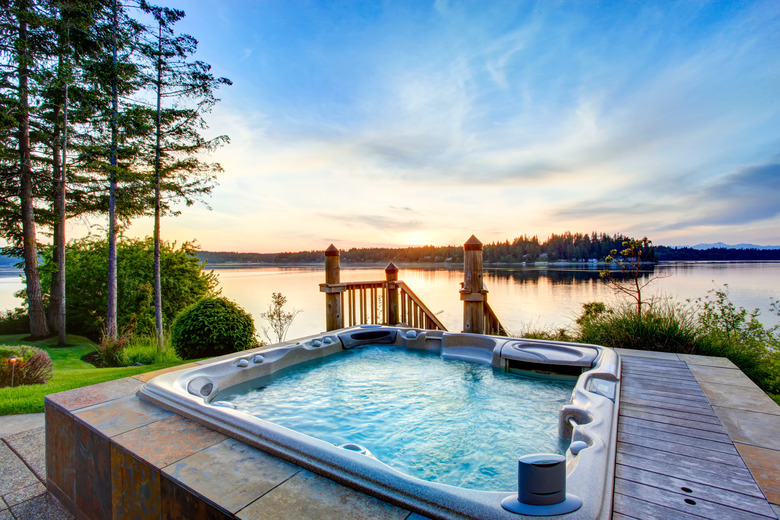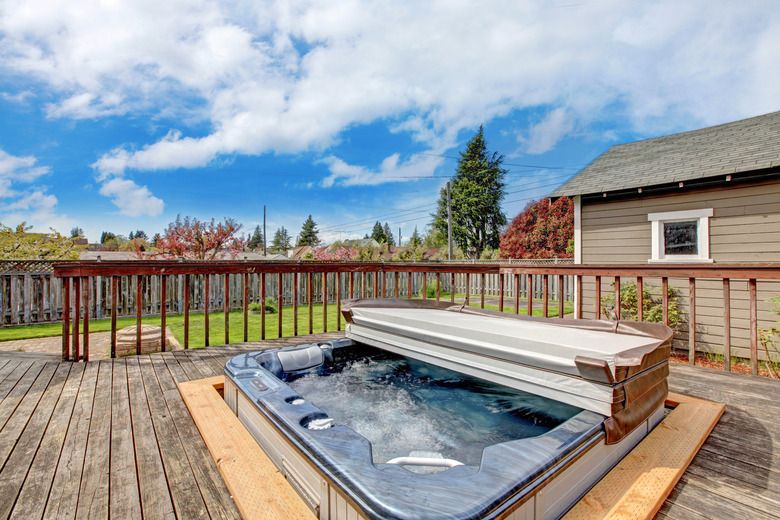How To Convert A Hot Tub To A Cool Plunge
The steam rolling off your hot tub looks mighty inviting on a cold winter day, but it probably looks stifling in the summertime. Fortunately, there are ways that you can turn down the temperature in your tub and cool the water — turning your hot tub into a "cool plunge," or a year-round relaxing backyard destination. Once you do, your hot tub will become a cool haven on hot summer days. You won't have enough room to swim laps, of course, but otherwise, a cool tub offers many of the same benefits as a swimming pool for hot tub owners.
Maintaining a Cool Hot Tub
It can take some time to cool the water in your hot tub, but once you get the temperature down, keeping it there is relatively easy. This is because your hot tub is insulated, and the insulation works both ways. It helps to keep your tub water hot in the winter, but it can also help keep the water cool and prevent it from heating up again.
For even more insulation, remember to put the cover back on your plunge pool when you're not using it. If your hot tub sits in direct sunlight, consider installing an umbrella or pop-up canopy above it for extra protection. The shade will help to keep both yourself and the water in your hot tub cooler.
How to Cool a Hot Tub
1. Adjust the Heat and Vent the Tub
The first step toward cooling your hot tub is adjusting the heater. Ordinarily, the water in your hot tub should sit at around 100 degrees Fahrenheit. When you're preparing your hot tub for summer use, turn the thermostat down to 85 degrees or lower. In very warm climates, you can turn it off altogether.
Next, you'll want to ventilate the hot tub and allow the heat to escape. You can take your tub cover off to do so, but this may be counterproductive if the tub sits in direct sunlight. In that case, vent the tub by placing a pool noodle or tennis ball under each corner of the hot tub cover. This will create a vent from which heat can escape without exposing the water to direct sunlight.
2. Add Water and Ice
Patience is a virtue, but it's a luxury for which you may not have time if you're hosting the neighborhood block party tonight. If you need to cool your hot tub in a hurry, drain out some of the water and replace it with cooler water from your garden hose.
As always, you'll need to adjust the chemicals in your tub after you add water. Doing so is a simple matter of testing the water with your spa test kit and then adding chemicals as needed. You don't need to modify the chemical treatment when you add cool water to the tub.
If you plan to cool your tub this summer, save a few empty milk jugs or other plastic containers. Fill them with water and freeze them. You can then toss the frozen jugs into the hot tub like giant ice cubes. You can add food coloring to the water in your jugs if desired to add a little color and fun to your tub.
3. Turn on Your Jets
Running the jets in your hot tub will help cool it faster — a trick that works particularly well in the evening. The jets will also help circulate any cold water that you've added to the tub.
Jets lower the water temperature by injecting cool air into it. The same thing happens when you use your hot tub in the winter. You don't notice it, however, as your hot tub's heater adjusts as needed to compensate for this heat loss.
4. Consider a Cooling System
Several manufacturers now make hot tub chillers. These units can cool the water in your hot tub to as low as 60 degrees Fahrenheit, usually reducing the water temperature by a degree or two per hour. Chillers work the same way as air conditioners but move water through the system rather than air. Some are installed within the walls of the hot tub, while others sit outside the tub.
Most people find a chiller unnecessary since the water in your hot tub need only be a few degrees cooler than the ambient temperature to offer relief from the heat. A chiller is a must, however, if you like using ice water therapeutically, as professional athletes do. You aren't likely to get your hot tub water cold enough to achieve this without the help of a chiller.
Whether you want to do some ice water therapy or just like a really cold pool, it's important to contact a pro if you decide you want a chiller. It's best to have these units installed by an HVAC or spa professional. Chillers use water and electricity in close proximity to each other and contain refrigerant chemicals, all of which make it best for DIYers to steer clear of installing them. Doing the work yourself could also void the warranties on both the chiller and the hot tub.
Tips for Using Your Cool Plunge
The best way to maintain your hot tub during your summer cool down is to keep doing what you've always done. Clean the tub walls and water jets with a white vinegar-soaked rag about once a week. Remove any scale build-up you see while cleaning and give the outside of the tub a quick wipe down as well as the inside. Remove and rinse the filter during your cleaning routine.
Maintain a pH between 7.2 and 7.8 and a total alkalinity between 80 and 120. If you use chlorine to sanitize your water, shoot for between 1.5 and 3.0 ppm. Bromine users should strive for 3.0 to 5.0 ppm. to help keep things clean. If you maintain these balances all summer, warming your hot tub up again is as simple as turning the heater back on; there won't be any need to drain and refill the tub first. (And FYI, it takes between 3 and 8 hours to reheat the tub.)
To help keep your water clean, it's good idea to shower before getting in the tub — the cleaner you are, the cleaner your tub will be. Consider stashing a couple of baseball hats next to your spa as well. The brim of your hat can help shield your face and keep the sun out of your eyes, and you can also tuck long hair under a baseball cap to prevent gels, hairspray and other hair care products from getting into your hot tub water so that you can keep it cleaner with less effort.
Another excellent tip is to float tennis balls in your hot tub after you use it. The fuzzy felt of the balls soak up the oil from your skin and help keep the water cleaner. As always, keep the cover on your tub when you're not using it to keep out falling leaves and other debris.
References
- Caldera Spas: How Can I Get More Use From My Hot Tub During Summer?
- Jacuzzi: 5 Tips to Stay Cool in Your Hot Tub
- Cal Spas: Hot Tubs Don't Have to Be Hot! 3 Reasons to Cool Off in Your Spa
- Imagine Backyard Living: Keeping Your Hot Tub Cool This Summer
- SpaCare.com: Understanding Spa and Hot Tub Water Chemistry / Spa Care
- Hot Tub Focus: Can Hot Tubs Be Used With Cold Water?

